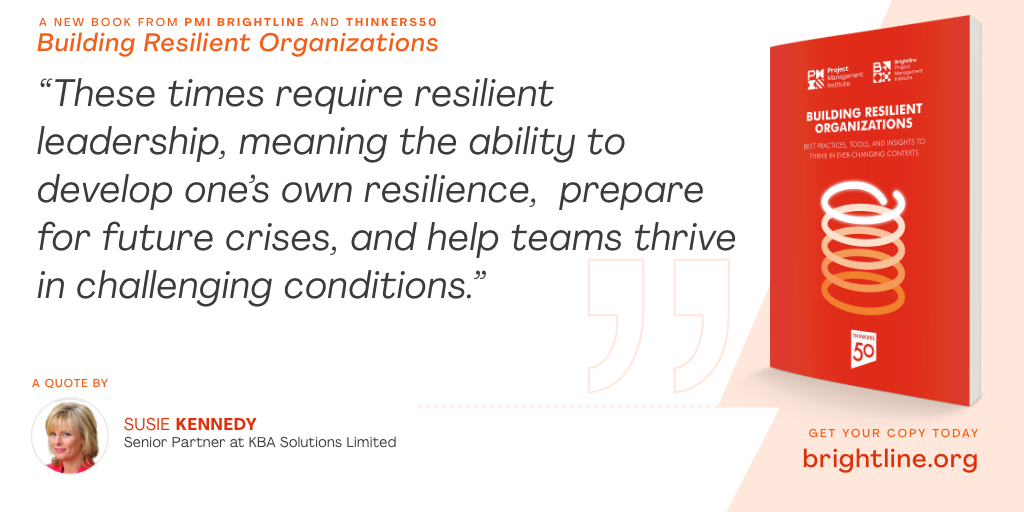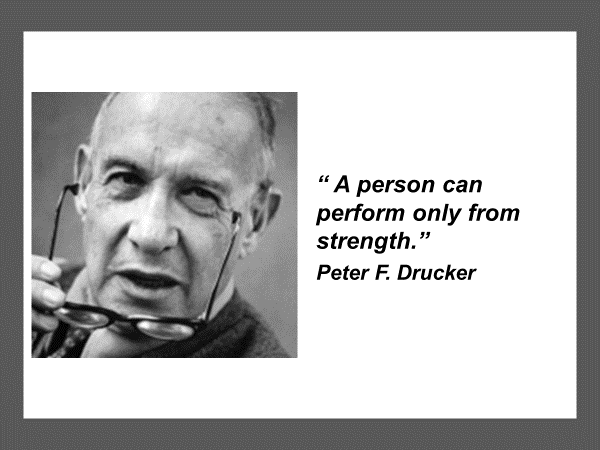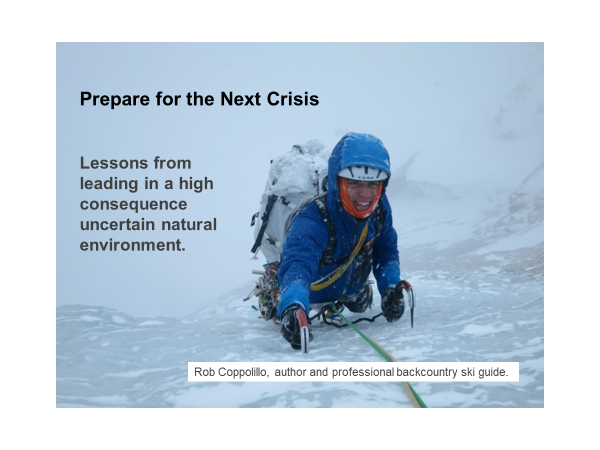Resilient Leadership: How to Build Resilience and Help Your Team Thrive
by Susie Kennedy
Resilient Leadership
The final paragraph of George S. Everly’s Harvard Business Review article of 24 June 2011 is thought-provoking1. Everly’s suggestion that in 2011 “To say we live in challenging times is an understatement” leaves us, by comparison in April 2022, with few adjectives to describe these times, other than these times. Just as the world is learning to cope with the COVID-19 global pandemic of the last two years, grapple with economic recovery, face the impact of climate change, and ongoing political and social challenges, on 24 February 2022 Russia invaded Ukraine, posing a massive geopolitical threat. At the time of this writing, the war has been raging for seven weeks, and the outlook is precarious. On 14 April 2022, Reuters news reported: “Russia warns of nuclear, hypersonic deployment if Sweden and Finland join NATO.”2

The impact of the war thus far is profound and far-reaching. According to Jacob Kern of the World Food Programme (WFP), more than 10 million people in Ukraine have been displaced in one month alone, a level that took 10 years to reach in Syria.3 Oil prices, already inflated, have soared, significantly increasing the cost of living.4 Grain, vegetable oil, and fertilizer prices have all increased due to supply shortages from Ukraine and Russia, leading to inflated food prices, the threat of poverty, and the perils of protectionism.
Many governments are imposing sanctions on Russia and its oligarchs, restricting trade and travel, and seizing assets. Nearly 600 companies have curtailed operations in Russia5, many voluntarily, others prompted by media criticism. Even the UK Chancellor of the Exchequer faced questions about connections to Russia through his wife’s family business, Infosys, which at the time still had an office in Moscow.6
Looking forward, threats of the rise of far-right nationalism, the return of former U.S. President Donald J.Trump in 2024, and the global divide in support for Russia7 suggest continued geopolitical and economic instability. Arguably, the only thing we can be certain about is that uncertainty and disruption will continue to dominate.
These times require resilient leadership, meaning the ability to develop one’s own resilience, prepare for future crises, and help teams thrive in challenging conditions. This article will consider how leaders can build resilience by including our research conducted during the COVID-19 crisis and lessons from leading in an uncertain natural environment.
First Develop Your Own Resilience
We are reminded by Peter F. Drucker that, “a person can perform only from strength.”8 In these times, leaders must strengthen their ability to cope with crises to help their teams thrive. Making time for reflection is one way to identify resilience strength.
We are reminded by Peter F. Drucker that, “a person can perform only from strength.”8 In these times, leaders must strengthen their ability to cope with crises to help their teams thrive. Making time for reflection is one way to identify resilience strength.

In Upheaval: How Nations Cope with Crisis and Change, Jared Diamond describes 12 factors, which, according to crisis therapists, make it more or less likely that a person will succeed in coping with a crisis9 (Table 1). He goes on to draw comparisons between how individuals and nations cope with crises. These factors are relevant to resilient leaders too. For example, Diamond suggests that in relation to the factor, experience of previous personal crisis, “If you have already had the experience of coping successfully with some different crisis in the past, that gives you more confidence that you can solve the new crisis as well.”
Table 1. Factors Related to the Outcomes of Personal Crises (Diamond, 2019)
Acknowledgement that one is in crisis
Acceptance of one’s personal responsibility to do something
Building a fence to delineate one’s individual problems needing to be solved
Getting material and emotional help from other individuals and groups
Using other individuals as role models of how to solve problems
Ego strength
Honest self-appraisal
Experience of previous personal crises
Patience
Flexible personality
Individual core values
Freedom from personal constraints.
Source: Diamond, G. M., (2019). Upheaval: How nations cope with crisis and change (Table 1.1, p. 39) Penguin.
We have been researching this area to find out how senior managers in UK local government coped with the COVID-19 crisis since the start of the first lockdown in March 2020. We spoke with senior managers from 60 local authorities who were leading the COVID-19 response in various roles, including responsibility for freeing up ICU beds by moving patients into nursing homes, establishing temporary mortuary sites, and distributing emergency food parcels to vulnerable residents.
We asked them to reflect on the question: “What have you learned about yourself and your organization that can help you in the future?” Analysis of the responses concluded eight key lessons, which were surprisingly positive and optimistic given the scale of challenges this sector has faced (Table 2).
Table 2. Lessons From the COVID-19 Crisis (KBA Solutions, 2022)
Individuals and organizations experience crisis in different ways.
You and your organization are more resilient than you thought.
Leaders must be compassionate and adapt their style to understand the needs of each individual.
Communicate frequently using different methods and focus on well-being.
Teams can work better together and collaborate more.
Crisis creates the opportunity to innovate.
New systems and ways of working are more efficient.
Look after yourself.
Source: KBA Solutions Limited (April 2022). Lessons from Covid crisis that will help in the future. Research in UK local government. Responses from senior management in 60 local authorities March 2020–March 2022.
A significant outcome of the research was that the act of reflection boosted managers’ confidence because it helped them realize how successful they were in coping with the crisis. We have incorporated these lessons in our suggestions for building resilient leadership in these three key areas:
Look after yourself.
Prepare for the next crisis.
Help your team thrive.

Look After Yourself
This sounds obvious, but it can be difficult to maintain well-being, especially when juggling homeschooling, childcare and other responsibilities while under pressure to deliver results. Yet it is essential to stay fit and healthy to build resilience. Practical suggestions to help boost personal resilience include:
1. Get good sleep, eat well, and exercise regularly. Our research showed during the COVID-19 crisis many managers experienced frustration, stress, and anxiety. getting enough sleep, ideally 7 to 8 hours yields major well-being benefits and can combat these effects.10 Sleep helps improve our decision-making, including the decisions about what we eat and how we exercise. So prioritizing sleep is essential for building resilience.
2. Reflect on what you have learned about yourself. The discipline of taking time for reflection, ideally with colleagues or a coach, pays off. As shown above, managers’ confidence was boosted by realizing how resilient they were. They recognized the crisis gave them the opportunity to seek improvements, and that new systems and new ways of working were more efficient than during prepandemic times. These insights provided new energy for tackling the next challenge.
3. Build a network of relationships to gain the support you need. We gain different types of support from different relationships. For example, colleagues can provide practical support by sharing workload and resources. Your boss can give you confidence by supporting you. Your friends can provide emotional support by listening to your frustrations; so, investing in relationships helps build resilience. Interestingly, our research indicated the combined effect of working from home in a less formal environment and increased frequency of online meetings—with more time devoted to well-being/social issues—appeared to increase trust and make it easier to build supportive relationships within teams and with stakeholders.
4. Take control and give it up. As mentioned above, managers can experience stress, anxiety, and feel overwhelmed with workload. With support, it is possible to take more control over your workload and create well-being time for yourself. Building a support network can help, as can simple acts such as changing technology settings to stop events from being automatically added to your calendar. Honing your digital skills to stay technically savvy will help you feel more confident. But you may also need to give up control. Be honest with yourself about how flexible you are and whether you are risking burnout because you won’t let go. Are you delegating enough? Do you think only you can deliver the right outcome? Must you chair every team meeting? Giving up some control can decrease your stress and give others new opportunities, so it’s worthwhile getting some honest feedback about areas where you can give up control.
Prepare for the Next Crisis
Professional backcountry ski guide and author, Rob Coppolillo works in a permanently uncertain, often dangerous natural environment guiding ski touring recreationists in North America and Europe. In his book, The Ski Guide Manual,11 recommended by The American Mountain Guides Association, we can learn many lessons to develop resilience by being prepared.
For Coppolillio, planning and preparation are crucial: “Our trip plan offers solutions and mitigation strategies before we find ourselves exposed to hazards like avalanches, rock and ice falls, dangerous cold or hot weather, or the disconnect of an incompatible team.”(Coppolillo, 2020, p.2)12 His approach to planning, based on the American Institute for Avalanche Research and Education (AIARE) Risk Management Framework includes these activities:
- Stay fit and healthy.
- Track the season’s conditions.
- Practice rescue.
- Learn about avalanches.
- Become an expert navigator.
- Investigate route options.
- Find compatible partners.
- Get your gear ready.13
Planning and preparation start late summer/early fall so that “when the backcountry finally fills in, you want to be ready mentally and physically.” (Coppolillo, 2020, p.3)14

In the same way professional ski guides prepare to stay mentally and physcially fit, have the right equipment, build knowledge of the environment and expertise to cope with it, plan their routes, and manage the team, so too must resilient leaders. Activities that help prepare for future uncertainty and build resilience can be distilled into the following key areas:
1. Clarify purpose. A recent Deloitte report indicates the importance of purpose orientation in building organizational resilience15. On a personal level, individuals with a strong sense of purpose tend to be motivated, with a passion for learning, developing, growing, and performing. A strong sense of purpose builds personal resilience, which in turn can cultivate a more engaged and resilient team and organization. This is consistent with our research, which found teams worked better because they shared a strong common purpose and values during the crisis. Leaders should routinely remind themselves of their own purpose and help their teams do the same so that everyone is mentally ready for the next challenge.
2. Know what’s coming up. Ski guides track conditions so they can assess the implications on avalanche risk later in the season. Pressure to deliver results can make it challenging for leaders to maintain strategic focus — to be able to see the wood for the trees. Yet, leaders need to be aware of the issues they are likely to face and plan for them. Using tools, such as PESTLE, Scenario Analysis, and MoSCoW, leaders can engage stakeholders in regular joint decision-making and problem-solving activities, capturing the advantages of divergent thinking styles. This approach is likely to result in better quality decisions and closer relationships.
3. Build a flexible adaptable workforce. The events of 2020 highlighted the importance of a flexible and adaptable workforce in building resilience. A recent Deloitte survey found three in four respondents who had taken steps to build flexibility had a more resilient culture. Leaders can build resilience in their workforce by having processes that facilitate easy redeployment (and meet ethical and legal standards), by recruiting staff for a learning mindset rather than a specific skill set, and by training staff in new skills including curiosity, creativity, and empathy. (Renjen, 2021)16
4. Resilience reviews. Deloitte suggests organizations have been forced to think more holistically about resilience within interlinked pillars. In preparing for future crises, leaders can review their financial resilience to ensure they can withstand impacts on income, assets and liquidity. A review of operational resilience to ensure business continuity will include reviewing investment in technology. A review of reputational resilience will ensure the goodwill and trust of stakeholders necessary to cope in challenging times.17
A final note is to remind leaders to be wary of devoting time unequally to more favorable preparatory activities. Coppilollo says: “The irony is, we often spend more time researching and buying a new set of skis than we do refining our skills for the upcoming winter.”(Coppolillo, 2020,p.3)18
Help Your Team Thrive
In the mountains, Coppilollo chooses to ski with high-performing teams as, he argues: “High-performing teams keep us safer, find better skiing, and have more fun too.”(Coppolillo, 2020, p.165)19 They reduce uncertainty by checking assumptions and collaborative decision-making. The role of the resilient leader is to create the conditions that allow their team to thrive and be high performing.
Over the last two years we have researched managers’ responses to the question: “What conditions allow your people to thrive?” Analysis of responses indicated seven categories of conditions:
Psychological safety
Physical safety, health, well-being, and work environment
Clear purpose and vision
Autonomy and empowerment
Challenge and achievement
Skills and learning opportunities
Teamworking.
We noted psychological safety was, by far, the most frequently cited condition for thriving. We also noted conditions for thriving as identified by managers in the survey mapped to our conditions for a thriving high-performing team (Table 3). This indicates the managers know what conditions they need to create to help their people and teams to thrive.

Table 3. KBA Diagnostic Tool—Conditions for a Thriving High-Performing Team
The team knows its purpose and common goal are compelling and motivating.
The team has meaningful and effective performance objectives.
The team has freedom to choose how it completes projects/tasks and accountability for delivery.
The team feels senior leadership expects it will achieve high standards and supports them (Pygmalion Effect).
The team has complimentary skills, including interpersonal, problem- solving, technical, and learning skills.
The team has agreed on ways of working and meaningful norms of behavior.
Individual team members believe their role in the team meets their personal development and social needs (feel valued, shown respect, and treated fairly).
Team members get to know each other and build relationships so they feel comfortable giving feedback about the team and tasks.
There is a shared belief that team members will not be punished or humiliated for speaking up with ideas, questions, concerns, or mistakes (psychological safety).
Excellent performance is celebrated and rewarded.
Source. KBA Solutions Limited (2018). These factors form the basis of our diagnostic tool to help leaders and teams develop high performance.
However, while managers know what conditions they need to create, how to go about creating them can be more or less challenging. For example, creating a shared purpose, common goal, performance objectives, and ways of working is relatively straightforward to achieve, whereas psychological safety is more complicated. Amy Edmundson, Novartis Professor of Leadership at Harvard Business School, introduced this factor. In The Fearless Organization20 she says, “Psychological safety is broadly defined as a climate in which people are comfortable expressing themselves.” (Edmondson, 2019, p.xvi)21 explaining, “They are confident they can speak up and won’t be humiliated, ignored or blamed.” (Edmondson, 2019, p.xvi)22
It is particularly important in uncertain high consequence environments, as Coppolillo recognizes, “We need to continuously create and foster a sense of psychological safety among teammates.” (Coppolillo, 2020, p.157)23 He argues it is a continuous priority, “not something we do in the fall and then let it grow stale throughout the winter. It requires ongoing attention, in guide meetings and trip plans with buddies.” (Coppopillo, 2020, p.157)24
A few practical ways resilient leaders can create the conditions for a high-performing team include:
1. Diagnose and prescribe. The leader can carry out an assessment of the extent to which the conditions exist that allow the team to be high performing using a diagnostic tool such as the KBA tool listed in Table 3. Team members then individually complete the diagnostic with the support of a coach who can then analyze all the responses and present the findings, initially to the leader and then in a group coaching workshop with everyone together. The team can then prescribe its own team development plan to create the conditions for high performance. Having created the plan themselves, they are more likely to follow it.
2. Learn how to create psychological safety. Creating psychological safety is difficult because it is contingent on the leader creating a positive climate. It means learning a set of new behaviors and skills in order to create shared expectations, atmosphere and structures to give people the confidence to speak up and to enable continuous learning.
Resilient leaders create a positive supportive environment by demonstrating behaviors such as consulting team members, asking them for input, showing concern for team members as individuals, and by using positive language/body language.
Creating and maintaining a positive supportive environment can be difficult to maintain when under pressure. Sometimes espoused behaviors are inconsistent with behaviours demonstrated, such as in the case of the manager who routinely reminds her team she has an open door policy but fails to be supportive when the team makes a mistake. Edmundson has developed a comprehensive toolkit for developing psychological safety and recommends leaders routinely take a leadership self-reflection assessment to help their development.25
So What?
Resilience is a strength leaders can develop. The resilient leader is mindful of the factors that help them succeed in coping with a crisis. They look after themselves physically and mentally. They prepare for the next crisis by ensuring maximum flexibility and adaptability and they create the conditions that allow their teams to become high performing.
As a human race, we are still here because we continue to develop resilience and help others to thrive.
That is the essence of resilient leadership.
About the author
Susie Kennedy is senior partner of KBA Solutions Limited, which she founded in 1993. KBA specializes in executive development and change leadership consulting. Susie has contributed to a number of Thinkers50 publications; she is Programme Director for KBA’s Institute of Leadership and Management Strategic Leadership program for senior managers, with programs in the University of Cambridge, Premier Foods, and nationally for UK Local Government at King’s College London.
Footnotes
1 Everly, G.S., (2011) Building a Resilient Organizational Culture. Harvard Business Review 24 June [online] Available at https://hbr.org/2011/06/building-a-resilientorganizat (Accessed 8 April 2022)
2 Reuters (2022) Russia warns of nuclear, hypersonic deployment if Sweden and Finland join NATO 14 April [Online] https://www.reuters.com/world/europe/russia-warns-baltic-nuclear-deployment-if-nato-admits-sweden-finland-2022-04-14/ (Accessed 14 April 2022)
3 Saladino, D. (2022, 10 April). The Food Programme: Ukraine The Food Dimension Part 2. [Radio Broadcast] Available at: https://www.bbc.co.uk/sounds/play/m0016818 (Accessed 10 April 2022)
4 Kolaczkowski, M (2022) How does the war in Ukraine affect oil prices? World Economic Forum, 4 March [Online] Available at https://www.weforum.org/agenda/2022/03/how-does-the-war-in-ukraine-affect-oil-prices/ (Accessed 15 April 2022)
5 Yale School of Management (2022) Over 600 Companies Have Curtailed Operations in Russia—But Some Remain. 15 April [online] Available at https://som.yale.edu/story/2022/over-600-companies-have-curtailed-operations-russia-some-remain (Accessed 15 April 2022)
6 (2022) UK finance minister Rishi Sunak questioned over Infosys presence in Moscow. [Online] The Economic Times. 25 March. Available from https://economictimes.indiatimes.com/news/international/world-news/uk-finance-minister-rishi-sunak-questioned-over-infosys-presence-in-moscow/articleshow/90432868.cms (Accessed 15 April 2022)
7 2022, Who are Russia’s supporters?, The Economist. 4 April [Online] Available at https://www.economist.com/graphic-detail/2022/04/04/who-are-russias-supporters. Accessed 10 April 2022.
8 Drucker, P. Managing Oneself. Harvard Business Review Classics. Boston, MA: Harvard Business Review Press. 2008
9 Diamond, J. Upheaval: How Nations Cope with Crisis and Change. Great Britain. Penguin 2020
10 Walker, M. (2017) Top tips to get a better night’s sleep and improve your health. [Online] New Scientist. 11 Oct. Available at https://www.newscientist.com/article/2149792-top-tips-to-get-a-better-nights-sleep-and-improve-your-health/#ixzz7QpEHxWBk (Accessed 18 April 2022)
11 Coppolillo, R. The Ski Guide Manual: Advanced Techniques for the Backcountry. Falcon Guides, Guildford, CT. 2020
12 Coppolillo, 2020, p.2
13 Coppolillo, 2020, p.2
14 Coppolillo, 2020, p.3
15 Deloitte (2021) The resilient organization. How to thrive in the face of uncertainty [Online] Available at https://www2.deloitte.com/ca/en/pages/risk/articles/the-resilient-organization.html?icid=learn_more_content_click (Accessed 8 April 2022)
16 Renjen, P (2021), Building The Resilient Organization, 2021 Deloitte Global Resilience Report [Online] Available at https://www2.deloitte.com/global/en/insights/topics/strategy/characteristics-resilient-organizations.html (Accessed 8 April 2022)
17 Renjen, P (2021), Building The Resilient Organization, 2021 Deloitte Global Resilience Report [Online] Available at https://www2.deloitte.com/global/en/insights/topics/strategy/characteristics-resilient-organizations.html (Accessed 8 April 2022)
18 Coppolillo, 2020, p.3
19 Coppolillo, 2020, p.16
20 Edmondson, A. The Fearless Organization: Creating Psychological Safety in the Workplace for Learning, Innovation, and Growth. Hoboken, NJ: John Wiley & Sons, 2019
21 Edmondson, 2019, p.xvi
22 Edmondson, 2019, p.xvi
23 Coppolillo, 2020, p.157
24 Coppolillo, 2020, p.157
25 Edmundson, 2018, pp 181-182
References
- Coppolillo, R., & Zacharias, C. (2020). The Ski Guide Manual: Advanced Techniques for the Backcountry (Manuals Series) (First ed.). Falcon Guides.
- Deloitte. (2021). The resilient organization. How to thrive in the face of uncertainty. https://www2.deloitte.com/ca/en/pages/risk/articles/the-resilient-organization.html?icid=learn_more_content_click
- Diamond, J. (2020). Upheaval: How nations cope with crisis and change. Penguin.
- Drucker, P. (2008). Managing oneself. Harvard Business Review Classics. Harvard Business Review Press.
- Edmondson, A. (2019). The fearless organization: Creating psychological safety in the workplace for learning, innovation, and growth. John Wiley & Sons.
- Everly, G. S.(2011). Building a resilient organizational culture. Harvard Business Review. https://hbr.org/2011/06/building-a-resilient-organizat
- Faulconbridge, G.Reuters. (2022, April 14). Russia warns of nuclear, hypersonic deployment if Sweden and Finland join NATO. Reuters. https://www.reuters.com/world/europe/russia-warns-baltic-nuclear-deployment-if-nato-admits-sweden-finland-2022-04-14/
- Kolaczkowski, M. (2022). How does the war in Ukraine affect oil prices? World Economic Forum, 4 March https://www.weforum.org/agenda/2022/03/how-does-the-war-in-ukraine-affect-oil-prices/
- Renjen, P. (2021). Building the resilient organization, 2021 Deloitte Global Resilience Report https://www2.deloitte.com/global/en/insights/topics/strategy/characteristics-resilient-organizations.html
- Saladino, D. (2022, 10 April). The food programme: Ukraine the food dimension Part 2. [Radio Broadcast] https://www.bbc.co.uk/sounds/play/m0016818
- The Economist. (2022, April 4) Who are Russia’s supporters? https://www.economist.com/graphic-detail/2022/04/04/who-are-russias-supporters.
- The Economic Times. (2022, March 25). UK finance minister Rishi Sunak questioned over Infosys presence in Moscow. https://economictimes.indiatimes.com/news/international/world-news/uk-finance-minister-rishi-sunak-questioned-over-infosys-presence-in-moscow/articleshow/90432868.cms
- Walker, M. (2017, Oct 11). Top tips to get a better nights sleep and improve your health. New Scientist. https://www.newscientist.com/article/2149792-top-tips-to-get-a-better-nights-sleep-and-improve-your-health/#ixzz7QpEHxWBk
- Yale School of Management. (2022, April 15). Over 600 companies have curtailed operations in Russia—But some remain. https://som.yale.edu/story/2022/over-600-companies-have-curtailed-operations-russia-some-remain














